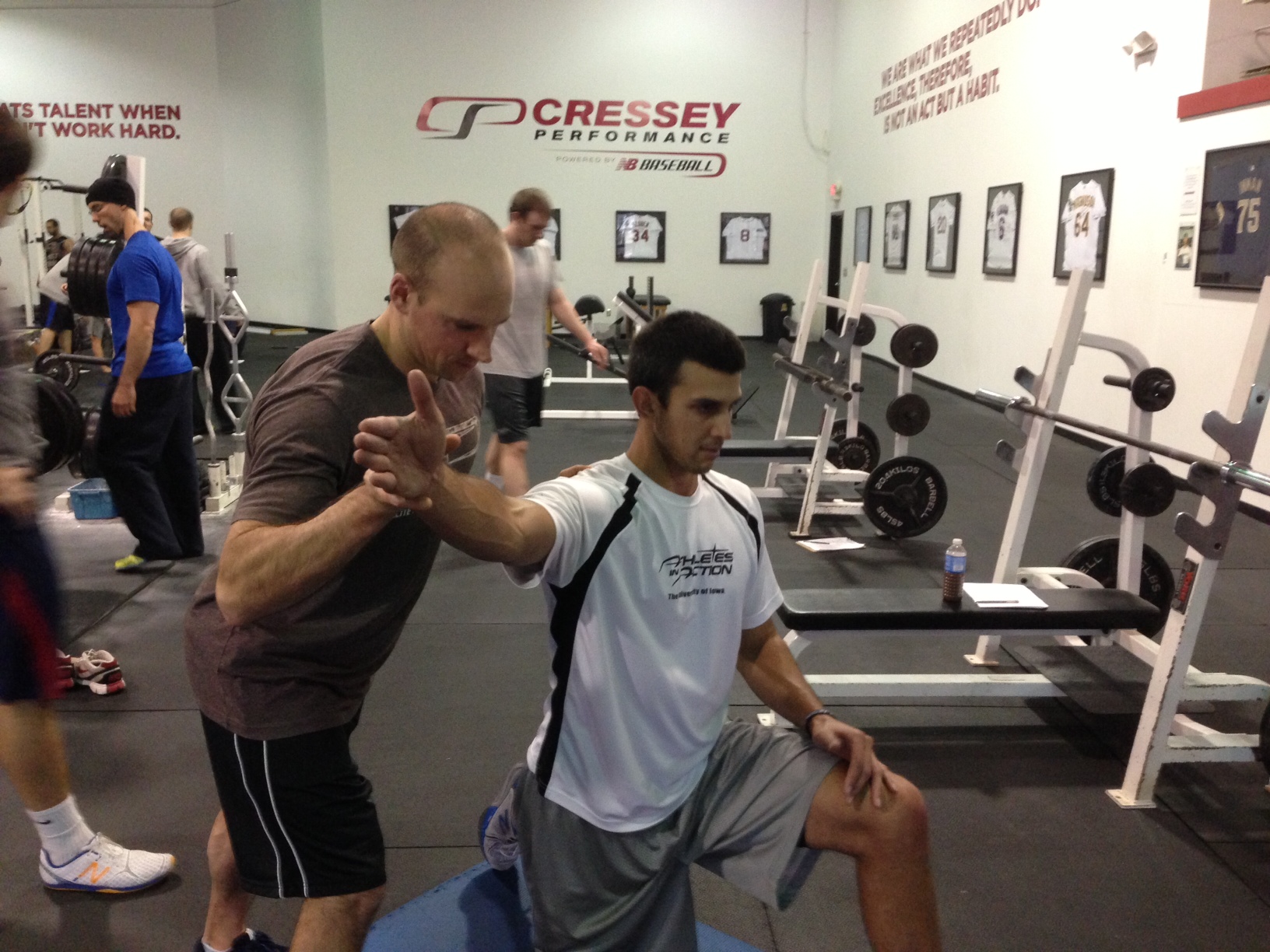I published a "Random Thoughts" article two weeks ago and it was really popular, so I figured I'd throw up another "brain dump" here.
1. I think it's important to differentiate between an athlete's 1-rep max (1RM) weight and a powerlifter's 1RM weight. Powerlifters may have a little wiggle room in technique at heaviest loads because lifting heavy weights is, in fact, their sport. That said, athletes lift weights to improve performance in sports other than lifting, and also to stay healthy. To that end, we always emphasize to our athletes that if you can't lift it in perfect technique, you shouldn't be lifting it; the risk: reward ratio is too high.
2. We do a lot of overhead medicine ball throws and stomps with our athletes. I see a lot of coaches miss out on some benefits in this context because they do all of it purely in the sagittal plane. Try integrating variations that also require some thoracic rotation to get to the release point. Here's one of our favorites:
3. I think "protective tension" should be a mandatory course in every exercise science, athletic training, and physical therapy curriculum. Not everything that feels "tight" needs to be stretched; that tightness might be the only thing keeping a person from slipping into debilitating pain. Take it away, and they may be in for a world of hurt.
This is actually a perfect example of the pendulum swinging in the other direction in the training and rehabilitation world; for the longest time, we've "assumed" that stretching was the one thing we could always fall back on as being "safe."
4. Here's one of my favorite quotes from my e-book, The Truth About Unstable Surface Training:
"While both efferent (motor) and afferent (sensory) processes contribute to overall neuromuscular function, the overwhelming majority of strength and power studies to date have looked exclusively at the efferent component. As a result, afferent contributions to strength, power, and athletic performance are frequently overlooked and largely undefined."
Taking this a step further, the overwhelming emphasis in sports performance training programs is on efferent development: producing force. What we don't realize is that in many cases, our ability to display efferent proficiency is severely limited by afferent shortcomings. This is one reason why you see so many people who are weight room rock stars, but just don't come across as all that athletic in sporting contexts. Sports performance training isn't just about making athletes strong.
Think about this as you're watching the NFL Combine this week. All the tests in question are closed-loop (predictable) in nature. The athletes all know exactly what they are supposed to do, so the evaluators are really just assessing efferent potential. Sure, there is sensory input involved in any athletic movement, but it's certainly not being assessed here.

5. Humeral retroversion is incredibly important for throwers. For those who aren't familiar with this term, give this classic article I wrote a read: Why President Obama Throws Like a Girl.
That said, what I don't delve into as much is what happens when a thrower doesn't have enough retroversion to allow for good lay-back, as demonstrated in the third frame in this sequence:

Well, normally it means they'll compensate via a number of other mechanisms:
a. Increasing lumbar and/or thoracic extension
b. cranking on the anterior shoulder capsule
c. stretching a lat or subscapularis past their optimal length-tension relationship (and possibly injuring them)
d. increasing valgus stress at the elbow. This can lead to medial tensile injuries such as UCL tears, ulnar nerve irritation, and flexor/pronator strains. Or, it can lead to lateral compressive injuries (little league elbow).

None of these compensations are really a good thing; you're much better off having good "true" ball-on-socket external rotation at the shoulder. So, there are really two takeaways from this point:
a. Make sure kids throw sufficiently at a young age to preserve retroversion while they are still skeletally immature.
b. If someone doesn't have sufficient retroversion, make sure you're controlling what you can control: soft tissue quality, thoracic extension mobility, maximizing end-range rotator cuff strength, etc. These are important for everyone, but particularly for someone who lacks lay-back.
6. If you don't have access to heavy dumbbells, but still want the benefits of them for upper body pressing, you have a few options.
First, you can always switch to 1-arm dumbbell bench presses. The instability reduces the amount of weight needed to achieve a training effect.
Stability is heavily dependent on one's base of support, too. With two feet on the ground and your entire back on the bench, you're pretty darn stable. However, if you only set up your upper back on the bench, you'll also still be able to get a great training effect with less loading. I think you'll find it to be a very challenging core stability exercise, too.

Sign-up Today for our FREE Newsletter and receive a four-part video series on how to deadlift!
| 













